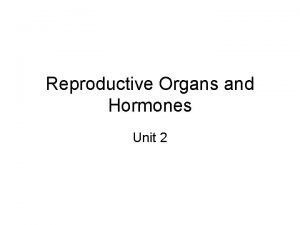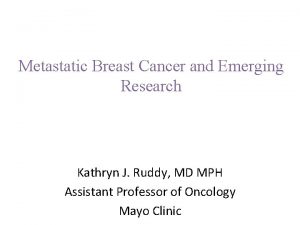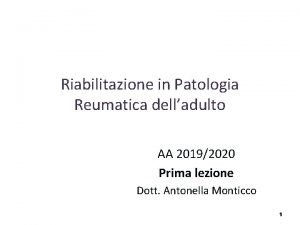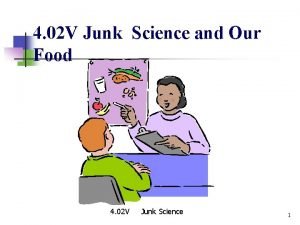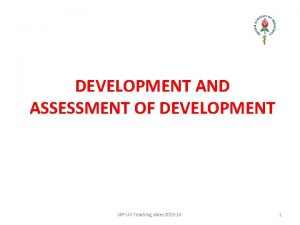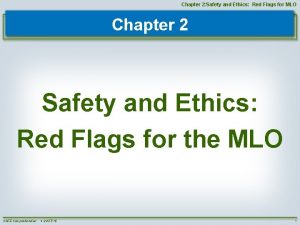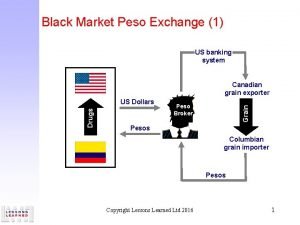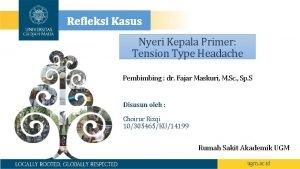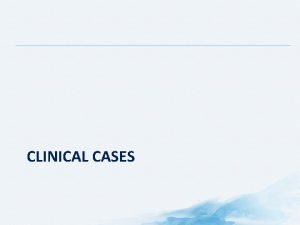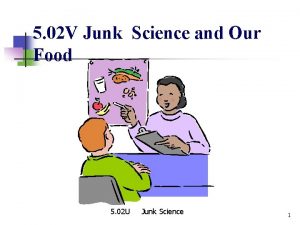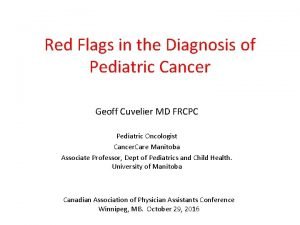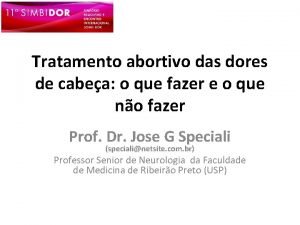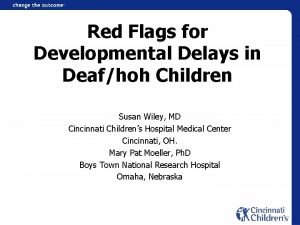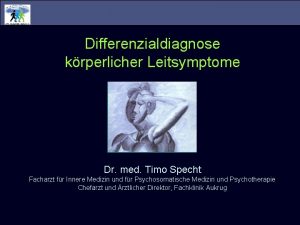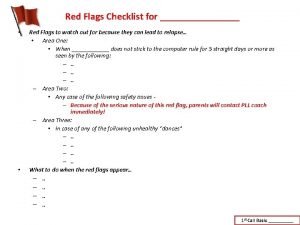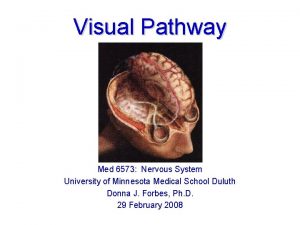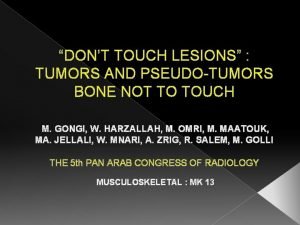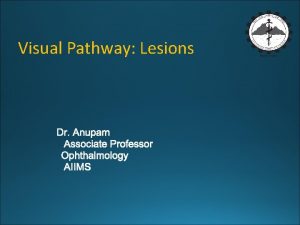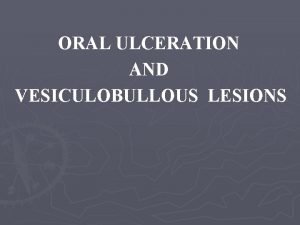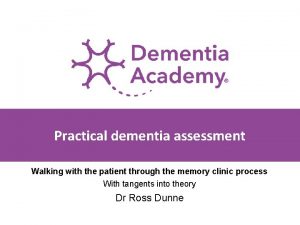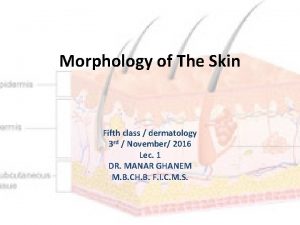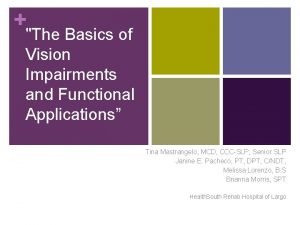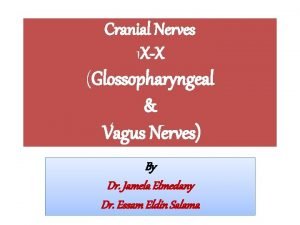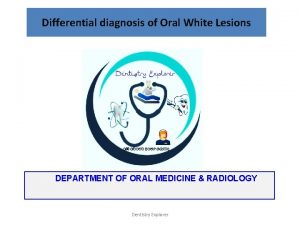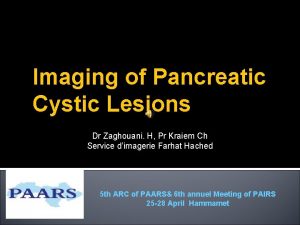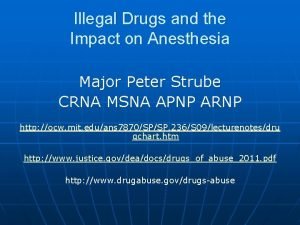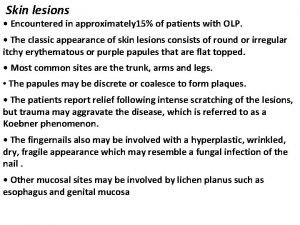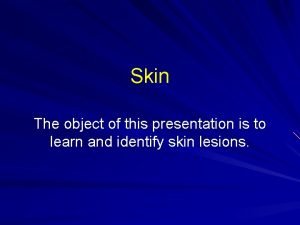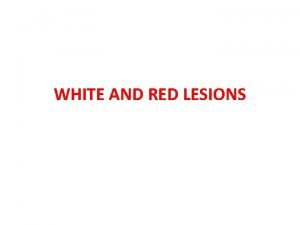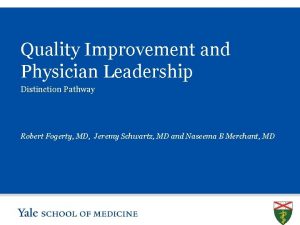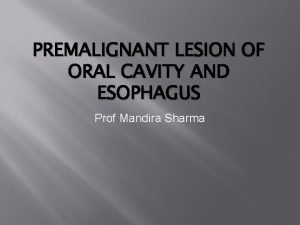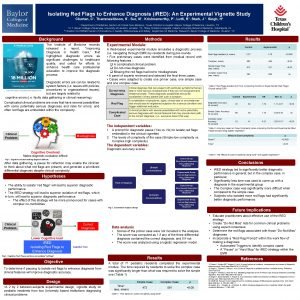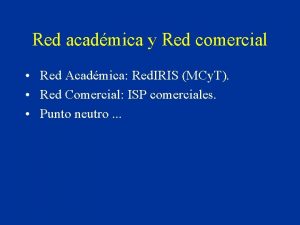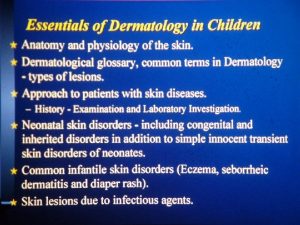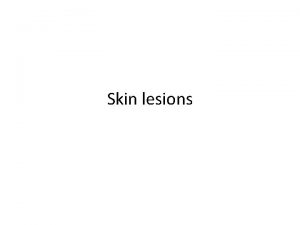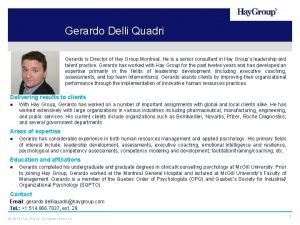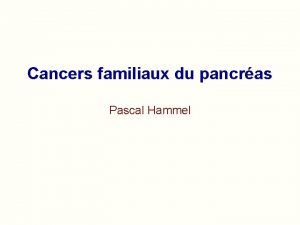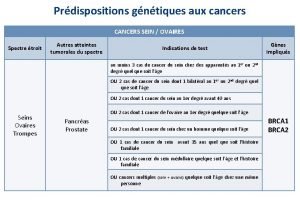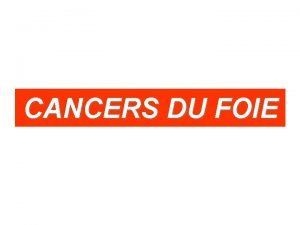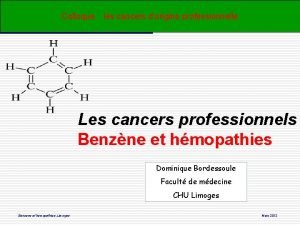PreCancerous Lesions Red Flags for future Cancers Gerardo











































- Slides: 43

Pre-Cancerous Lesions: Red Flags for future Cancers Gerardo H. Cornelio. MD, FPCP, FPSMO, FPSO

Magnitude of Cancer Problem in the Philippines INCIDENCE n n 3 rd in incidence after communicable & cardiovascular diseases 1 out of 1, 000 Filipinos has cancer 114: 103 Females to Males, Filipino Incidence rates increase w/ Age: 2 0 -14 yr. : 3. 6% of cancers 2 >35 yr. : 91% of cancers 2 >=50 yr. : 76% of cancers

THE TEN LEADING CANCER SITES IN THE PHILIPPINES Philippine Cancer Facts and Estimates, 1998

ESTIMATED LEADING CAUSES OF CANCER DEATHS Philippine Cancer Facts and Estimates, 1998

TEN LEADING CANCER SITES IN MALES NASOPAHRYNX(7) LUNG(1) PROSTATE (3) COLON(5) RECTUM(9) ORAL(10) LYMPHOMA (8) STOMACH(6) LIVER(2) LEUKEMIA(4) Philippine Cancer Facts and Estimates, 1998

TEN LEADING CANCER SITES IN WOMEN BREAST(1) THYROID(4) LUNG(3) LIVER(8) OVARY(5) CERVIX(2) STOMACH(9) UTERUS(10) COLON(7) LEUKEMIAS(6) Philippine Cancer Facts and Estimates, 1998

What are the Top Ten Cancers in the Philippines?

Genetics CANCER Environment Proliferation Anaplasia Clinical Manifestations Metastasis Preventive Curative Supportive Biopsy DIAGNOSIS Staging MANAGEMENT

THE NINE WARNING SIGNS C • Change in bowel or bladder habits. A • A sore that does not heal. U • Unusual bleeding or discharge. T • Thickening of a lump in breast or elsewhere. I • Indigestion or difficulty in swallowing. O • Obvious change in a wart or mole. N • Nagging cough or hoarseness. U • Unexplained anemia. S • Sudden, unexplained weight loss.

What is Cancer?

CANCER CELLS AND NORMAL CELLS CANCER CELLS NORMAL CELLS Frequent mitoses Normal cell Nucleus Blood vessel Few mitoses Abnormal heterogeneous cells Loss of contact inhibition Oncogene expression is rare Increase in growth factor secretion Intermittent or co-ordinated growth factor secretion Increase in oncogene expression Loss of tumor suppressor genes Presence of tumor suppressor genes

Cancer Genes Proto-oncogenes – normally promote normal cell growth; mutations convert them to oncogenes. n Tumor suppressor genes – normally restrain cell growth; loss of function results in unregulated growth. n DNA repair genes – when faulty, result in an accumulated rate of mutations. n

ONCOGENES

Multistage Carcinogenesis

CARCINOGENS n n Occupation related causes Lifestyle related causes n n n n Tobacco Diet Sexual practices Multifactorial causes Viral carcinogens Chemical carcinogens Ionizing radiation

Occupational Risk Factors Etiology Site of Malignancy Arsenic Asbestos Benzene Benzedine Chromium cpds Radiation (mining) Mustard gas Polycyclic hydrocarbons Vinyl Chloride Lung, skin, liver Mesothelium, lung Leukemia Bladder Lung Numerous locations Lung, skin Angiosarcoma of liver

Lifestyle Risk Factors Tobacco-related: n Lung cancer n Pancreatic cancer n Bladder cancer n Renal cancer n Cervical cancer

Diet-Related Risk Factors Nitrates Salt Low vitamins A, C, E Low consumption of yellow-green vegetables Gastric Cancer Esophageal Cancer

Diet-Related Risk Factors High fat Low fiber Low calcium High boiled or fried foods Colon Cancer Pancreatic Cancer Prostate Cancer Breast Cancer Uterine Cancer Mycotoxins Liver Cancer

Sexual Practices Risk Factors Sexual promiscuity Multiple partners Unsafe Sex Human Papillomavirus Cervical Cancer

Multifactorial Factors Tobacco + Alcohol Tobacco + Asbestos Tobacco + mining Tobacco + uranium + radium Oral Cavity Cancer Esophageal Cancer Respiratory Tract Cancer Lung Cancer

Chemical Carcinogenesis Normal Cells Initiator(s) (electrophilic, mutagenic) Chemical Carcinogen Promoter(s) Inactive Metabolites Initiated Cells Tumor Cells Clones Gross Tumors

Radiation Carcinogenesis Radiation-induced mutation in the host cell n Transmits irreversible changes in gene expression to cell progeny n

Sources of Potentially Carcinogenic Radiation Sunlight n Artificial sources of UV light n X-rays n Radio-chemicals n Nuclear fission n

Viral Carcinogenesis n Viral carcinogens are classified into RNA and DNA viruses. n Most RNA oncogenic viruses belong to the family of retroviruses that contain reverse transcriptase mediates transfer of viral RNA into virus specific DNA.

Sequence of Disease Progression Leukoplakia / Erythroplakia Dysplasia Carcinoma in situ Invasive Carcinoma Regional / Distant Metastasis


Lung Cancer Profile Smoke: 25 or more 15 – 24 14 or lower + 50 + 25 + 10 1 or more cigars the past year +5 3 or more vegetables a day -5 Parent, brother or sister w lung cancer + 10 Lived with a smoker +5 Live near a large city for 10 years +5 Asbestos worker without protection 5 -20 yrs/ >20 +25 /50 Radon, Cadmium, aluminum, silica, sulfur 5 -20 />20 +10 / 25 Eats 3 or more servings of fruits per day -5

Risk Chart Score Your risk is: Less than 0 Very much below average 0 -6 Much below average 7 - 10 Below average 11 - 12 Average 13 - 21 Above average 22 - 53 Much above average 54 or higher Very much above average

Lung Cancer n Bronchial intraepithelial lesions n Squamous metaplasia or dysplasia in former smokers n Loss of retinoic acid receptor-B expression

BREAST CANCER Signs and symptoms at presentation l Mass or pain in the axilla Palpable mass l Thickening l Pain l Nipple discharge l Nipple retraction l l Edema or erythema of the skin

Non Invasive Breast Cancer n Lobular Carcinoma in situ (LCIS) n n n Premalignant 20% develop IBC over 15 years 30% bilateral Annual mammography / Tamoxifen risk reduction (56%) – NSABP P 1 Ductal Carcinoma in situ (DCIS) n n n Malignant Recurs in 35% in 10 -15 yrs if biopsy alone >25% develop IBC

BREAST CANCER Mammography

BREAST CANCER Signs and symptoms at presentation l Mass or pain in the axilla Palpable mass l Thickening l Pain l Nipple discharge l Nipple retraction l l Edema or erythema of the skin

BREAST CANCER Signs and symptoms at presentation l Mass or pain in the axilla Palpable mass l Thickening l Pain l Nipple discharge l Nipple retraction l l Edema or erythema of the skin

Colorectal Cancer n Philippines n 3 rd leading cancer site n 3 rd in males n 4 th in females n 4 rth leading cause of death


RECTAL CANCER Sigmoidoscopy All rights reserved. Dr Ligoury, CNRI.

COLON CANCER Flexible sigmoidoscopy All rights reserved. Dr Larpent, Clermont-Ferrand; CNRI.

Precancerous Lesions n G-E Junction q GERD / Acid reflux q H. Pylori infection Kidney Intratubular epithelial dysplasia

Genital Warts n Human Papilloma Virus n Main risk factor for cervical cancer n Treatment: n Vaccine n Early detection

Skin Actinic keratosis n Atypical or dysplastic nevi n Premalignant Lentigo n n Causes: UV radiation n Genetics n Exposure to carcinogens like Arsenic, Tar, X-ray n

THANK YOU!
 Female reproductive cancers
Female reproductive cancers Her2 positive cancers
Her2 positive cancers Future perfect continuous tense sentences
Future perfect continuous tense sentences Future perfect continuous and simple
Future perfect continuous and simple Red flags lombalgia
Red flags lombalgia Food red flags
Food red flags Red flags of junk science
Red flags of junk science Bidextrous grasp
Bidextrous grasp Income statement red flags
Income statement red flags Occupancy fraud red flags
Occupancy fraud red flags Black market peso exchange examples
Black market peso exchange examples Red flags nyeri kepala
Red flags nyeri kepala Headache red flags
Headache red flags Vertigo peripheral vs central
Vertigo peripheral vs central Red flags of junk science
Red flags of junk science Headache red flags
Headache red flags Dores abortivas
Dores abortivas Red flags for developmental delays
Red flags for developmental delays Bis red flags
Bis red flags Red flags alarmsymptome der medizin
Red flags alarmsymptome der medizin Red flag checklist
Red flag checklist Monocular visual field
Monocular visual field G j mount classification of caries
G j mount classification of caries No touch lesions bone
No touch lesions bone Pie in the sky lesion
Pie in the sky lesion Vesiculobullous lesions
Vesiculobullous lesions Scattered white matter lesions
Scattered white matter lesions Primary and secondary lesions of skin
Primary and secondary lesions of skin Eye lesions
Eye lesions Nature lésions
Nature lésions Lesions of glossopharyngeal nerve
Lesions of glossopharyngeal nerve Extrapyramidal tract function
Extrapyramidal tract function Leukoedema histology
Leukoedema histology Daughter mother grandmother pancreatic lesions
Daughter mother grandmother pancreatic lesions Olneys lesions
Olneys lesions Site:slidetodoc.com
Site:slidetodoc.com Chronic hyperplastic candidiasis
Chronic hyperplastic candidiasis Describing skin lesions
Describing skin lesions Acute and chronic apical periodontitis
Acute and chronic apical periodontitis Extrapyramidal tract names
Extrapyramidal tract names White lesions
White lesions Lésions
Lésions Necrosis
Necrosis Premalignant lesions of esophagus
Premalignant lesions of esophagus
